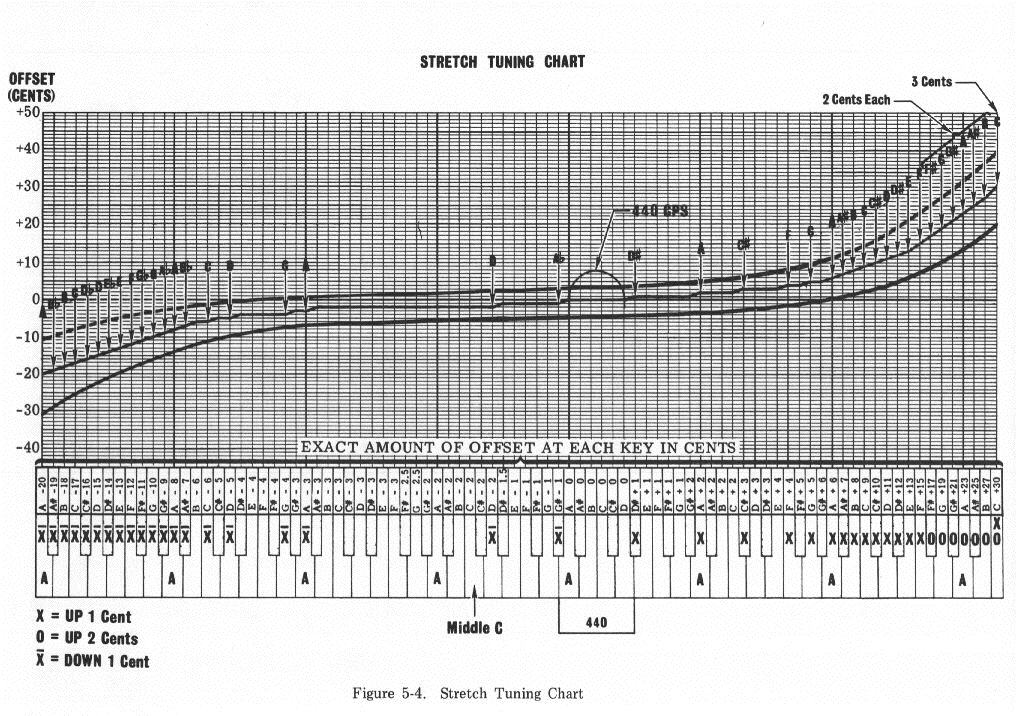I’m waiting for parts before I can proceed with the Seventy Three so I thought I’d use the time to try retuning my Fifty Four. According to the Service Manual, Rhodes pianos are tuned to equal temperament at the factory – each note is tuned to its theoretically correct frequency. I’m not certain why that is as I don’t think there’s much question that stretch tuning is more appropriate. I’ve never fully understood the theory behind stretch tuning so I’ll leave it to Wikipedia to provide the back story.
I’ve heard more than once that Rhodes pianos are notorious for going out of tune. Even though mine spent more than a few years being moved around on a regular basis, I guess it’s led a relatively sheltered life. In all the years I’ve owned it, I don’t think I’ve ever adjusted the tuning and according to my tuner, the tines haven’t moved very far off their targets.
Generally, the pitch of a particular note is determined by the size of the tone bar and length of the tine. By themselves though, the tone bar and tine are engineered to produce a pitch somewhere only in the neighborhood of the desired value, give or take a half step. To get the rest of the way, little springs are wrapped around the tines. The pitch can be fine-tuned by sliding the springs along the length of the tine. Making this adjustment can be tricky business though and I went through a few different ideas trying to find the easiest approach.
Perhaps the most interesting attempt involved a Dremel engraver. I chucked a modified screwdriver into the tool thinking maybe the reciprocating vibrations it produced might help move the springs in a controlled manner. It actually worked to a degree but was a pain to use and not really worth the effort.
Vintage Vibe sells a standard tack puller as a tuning tool. The angle on the end allows you to reach around the tone bar and the notch cut in the end helps to catch the spring. I found it hard to control the adjustments I was making, particularly on the higher notes where smaller and smaller movements are required to make the same pitch adjustments. For a while, I tried using a small hammer to tap the tool’s handle as it pushed against the spring but it was still too difficult to give it just the right nudge.
There is an alternative to using the keys to sound the notes while adjusting the tuning. The harp assembly is mounted on two arms that, after a few screws are removed, allow it to swing up clear of the hammers and dampers. Even though the hammers can’t reach, the tines remain positioned in front of their pickups and the harp can remain plugged into the amplifier. From here, the tines can be plucked and the springs can be moved by hand. I quickly found that very small adjustments could be made by twisting the springs around the tines while applying just a little pressure in the proper direction. This suddenly made it much easier to get even the treble end locked onto the exact pitches.
Traditionalists tune pianos by ear. They strike a tuning fork and match a note, then finish the keyboard by listening for the ‘beats’ made when two nearly identical wavelengths collide. This involves skills I don’t currently possess and for this job, I availed myself of the Peterson StroboFlip tuner. A strobe tuner is a significant upgrade from regular quartz tuners. Compared to the erratic wanderings of the quartz devices, the stability of the strobe’s display makes it a pleasure to work with. The Peterson also allows a much finer control and wider range of pitch offsets making it easier to use for stretch tuning. I recorded a video of the Peterson at work showing how accurate it allows you to be.
To find the proper offset values to use, I referred to the chart provided by the Rhodes Service Manual. A4 (the A above Middle C) is used as a starting reference and is tuned to the standard 440 Hz. As progress is made away from A4, notes are tuned increasingly further away from their mathematically-correct frequencies. Higher notes are adjusted sharp and lower notes are flattened.
The result of this tuning process should be an instrument that sounds more in tune than one set to an equal temperament tuning. I don’t hear it. I played another take of Recorda-Me after retuning. Comparing this to the same tune recorded before, I can’t tell the difference. On a Seventy Three’s wider scale, the “stretching” would be even more pronounced so maybe I’ll have a greater appreciation when I get one of those tuned up.


